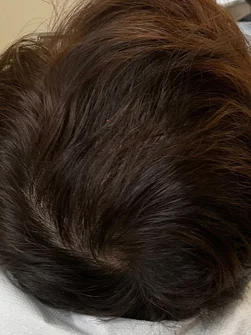Introduction
One of the most common questions we hear at Fortes Clinic is about hair transplant density. Patients want to know exactly how full their hair can look after the procedure and whether it will match their natural hair thickness. Achieving the right density depends on several factors, including donor hair supply, surgical technique, and long-term planning. This article explores how density is determined, what results you can realistically expect, and how to maximise the fullness of your transplanted hair.
What Does Hair Transplant Density Mean?
Hair transplant density refers to the number of follicular units (grafts) placed per square centimetre of scalp. In a natural, healthy scalp, density can range from 80 to 120 follicular units per square centimetre. During a transplant, surgeons aim to recreate a natural look without compromising graft survival.
At Fortes Clinic, we focus on strategic placement of grafts to achieve maximum visual impact. This often means placing more grafts at the hairline for definition while using fewer towards the crown to create a blended, natural appearance.
Learn more about how a hair transplant works to understand graft placement in detail.
Factors That Influence Density
Donor Hair Supply
The availability of strong, healthy donor follicles from the back and sides of the scalp is the most important factor in determining achievable density. Patients with thick donor hair can achieve fuller results than those with finer hair or limited donor availability.
Technique Used
Modern methods such as FUE and FUT allow precise placement of grafts, maximising density while maintaining natural spacing. Surgeons also consider hair calibre, curl, and colour contrast with the scalp to enhance the appearance of fullness.
Scalp Characteristics
The texture and elasticity of your scalp play a role in how densely grafts can be placed. A flexible scalp allows for closer graft positioning, while a tighter scalp may require wider spacing to prevent damage.
Patient Goals
Some patients want maximum coverage, while others prefer a natural, age-appropriate look. During consultation, we assess these goals to design a customised treatment plan that balances density with long-term preservation of donor hair.
Realistic Density Outcomes – Patient Scenarios
Not every patient needs or wants the same density. For example, a younger patient with early thinning may only need 1,500 grafts to strengthen the hairline and blend with existing hair. An older patient with extensive baldness might require staged sessions of 3,000–4,000 grafts to achieve satisfactory coverage.
At Fortes Clinic, every treatment is tailored to individual needs, ensuring results look natural and sustainable. This personalised approach allows us to optimise visual density without compromising follicle survival or future transplant options.
Recovery and Maximising Density
Post-surgery care significantly impacts the final density. Patients should avoid touching or scratching the scalp during the healing period, sleep with their head elevated for the first week, and follow prescribed shampooing routines to prevent follicle displacement. Avoiding intense exercise for at least 10 days helps protect the grafts.
As transplanted follicles enter their natural growth cycle, density gradually improves over several months. Visible results often appear after four to six months, with full thickness developing between 12 and 18 months.
Learn about how long a hair transplant lasts and what to expect during recovery.
Myths About Hair Transplant Density
Many believe that packing the maximum number of grafts into one session guarantees better results. However, placing grafts too close together can damage follicles and lower survival rates. Similarly, some think a single session can fully restore density in severe baldness, but staged procedures are often needed for the most natural outcome.
Planning for Multi-Session Density
Advanced hair loss may require more than one session to gradually build up density. At Fortes Clinic, our surgeons carefully plan initial and future sessions to preserve donor hair while optimising coverage. This phased approach ensures layering that looks natural and avoids overharvesting.
Complementary Treatments for Thickness
Combining hair transplantation with other therapies can enhance overall fullness. PRP therapy uses growth factors from your blood to rejuvenate hair follicles, while medications such as Finasteride help protect existing hair from further loss.
These complementary treatments create a thicker, healthier scalp environment, improving the perceived density of both transplanted and native hair.
Hair Transplant Density vs Natural Hair
It’s important to set realistic expectations. Even with the best technique and donor supply, it’s rare to achieve the same density as untouched, youthful hair. However, by strategically placing grafts and blending them with existing hair, surgeons can create the appearance of a much fuller head of hair that looks natural in all lighting and angles.
Psychological Impact of Restored Density
Achieving restored density often brings a renewed sense of confidence. Patients frequently report feeling more comfortable in professional and social settings, no longer worrying about concealing thinning areas. This boost in self-esteem can positively influence other aspects of life as well.
The Role of Surgeon Expertise in Achieving Density
While technology and donor supply are important, the expertise of the surgeon performing the procedure plays the biggest role in achieving a dense and natural-looking result. A highly skilled surgeon understands the precise angle and direction each follicular unit must be placed to mimic natural hair growth. They also know how to balance density at the hairline with coverage across the scalp, ensuring a result that looks full while preserving grafts for future procedures if needed.
At Fortes Clinic, our surgeons take the time to evaluate each patient’s unique hair characteristics, including thickness, curl pattern, and colour contrast with the scalp. This level of detail allows us to design transplants that provide maximum visual impact without compromising long-term results. Many patients who previously had unsuccessful or low-density procedures elsewhere choose Fortes Clinic for corrective surgery because of our reputation for achieving consistent and natural fullness.
Why Choose Fortes Clinic?
At Fortes Clinic, we pride ourselves on using advanced techniques and personalised planning to achieve the best possible density for each patient. Our surgeons consider every detail, from graft placement to long-term hair preservation, ensuring results that look natural and age gracefully.
Conclusion
Hair transplant density varies based on multiple factors, but with expert planning and modern techniques, most patients can achieve natural-looking fullness that lasts a lifetime. To understand your options and get a tailored assessment, contact Fortes Clinic today and take the first step towards restoring your confidence.



